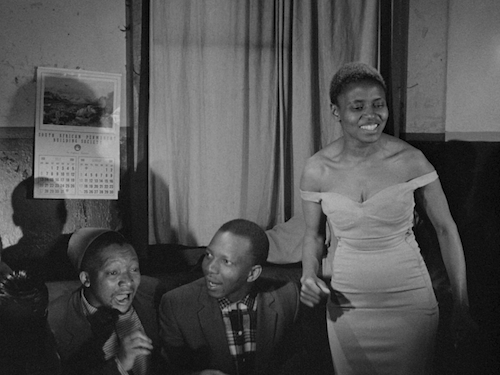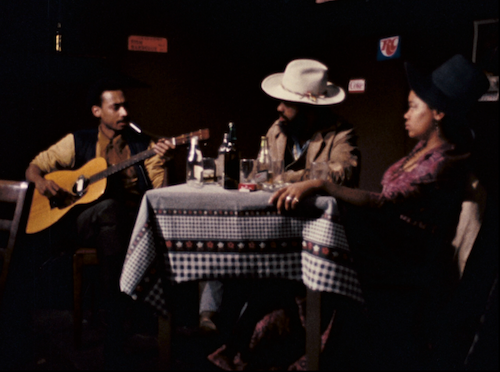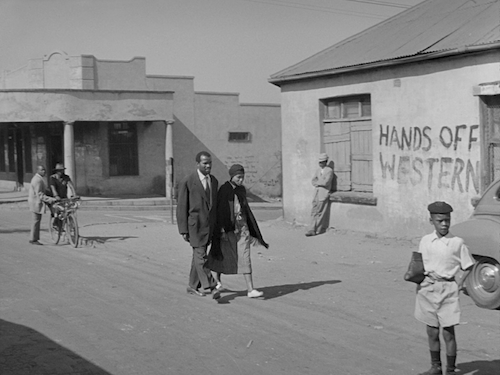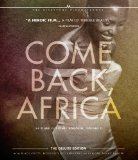| Reviews & Columns |
|
Reviews DVD TV on DVD Blu-ray 4K UHD International DVDs In Theaters Reviews by Studio Video Games Features Collector Series DVDs Easter Egg Database Interviews DVD Talk Radio Feature Articles Columns Anime Talk DVD Savant Horror DVDs The M.O.D. Squad Art House HD Talk Silent DVD
|
DVD Talk Forum |
|
|
| Resources |
|
DVD Price Search Customer Service #'s RCE Info Links |
|
Columns
|
|
|
Come Back, Africa - The Films of Lionel Rogosin, Volume 2
The Movies:

Milestone has finally delivered another double feature of films from influential but under-recognized director Lionel Rogosin. The first set featured his landmark drama/documentary hybrid On The Bowery and the experimental anti-war documentary Good Times, Wonderful Times, plus gobs of supplementary programs. This second collection follows much the same template as the first, including another outstanding drama/documentary hybrid, Come Back, Africa, another experimental documentary, Black Roots, and gobs of supplementary programs.
First up is Come Back, Africa, a clandestinely created anti-Apartheid drama, shot using non-actors in South Africa in 1959. Beautifully restored by the Cineteca di Bologna, the film succeeds not only as a hackles-raising piece of activist filmmaking but as a gorgeously shot time capsule of a bygone way of life. Not that that way of life seems all that appealing: even setting aside Rogosin's tragic storyline, the visual difference between modern, metropolitan Johannesburg and the shambling, unpaved Sophiatown ghetto where our main characters are forced to live is a jaw-dropping juxtaposition that is frankly unacceptable.
On top of this our main character Zachariah (Zacharia Mgabi) is constantly in fear of being jailed for not having his passes perpetually up-to-date. You see, you need a pass to live in Johannesburg and you need a pass to work in Johannesburg. Zachariah, a transplant from Zululand, tries to establish himself in his new locale by getting a job, allowing him to stay and support his wife and kids. But the system is set up to benefit no one but the white bosses. Zachariah gets hired and fired from a half dozen jobs, jeopardizing his security.
Rogosin and his African co-writers Bloke Modisane and Lewis Nkosi save Zachariah from being a one-dimensional martyr by showing him getting fired as often for his own mistakes as for the unjust choices of his white employers. This makes Zachariah much like Ray in On The Bowery, who was both a victim of his circumstances and a victim of his own habits; in that film, Ray manages to get a spot in a homeless shelter but then chooses to give up the security and go out boozing instead.
There's also other treachery looking to get Zachariah and his family. Neighborhood gangsters, called tsotsis, roam the ghetto, ready to make trouble. When Zachariah talks back to one of them in the corner store, it's not too long before the tsotsi comes after him in the street with a blade.
The other side of this depressing coin is the vibrant music created by the people of Sophiatown, which Rogosin and his crew capture live on the streets and which punctuates the dramatic vignettes. Often created simply with penny whistles and makeshift drums, the street music has an exuberance and energy that belies the circumstances under which it is made.
Miriam Makeba, who fled South Africa and became an international singing star shortly after the film's completion, sings a few songs during an intimate party scene where a handful of dissidents meet up to drink and discuss what needs to happen in their country. In Come Back, Africa, the jubilant release of music is always entwined with the struggle of its impoverished, exploited characters.
The acting in Come Back, Africa, as in On The Bowery, is a little rough, which is not surprising considering the inexperience of the performers. Their natural personalities overcome their weak line readings, however, and make the film's dramatic scenes fascinating to watch. In fact, Mgabi's performance in the shocking final scene is heartbreaking.
The whole film is in many ways incredible, not the least for the repressive conditions under which it was secretly made. Come Back, Africa is an astonishing work that captures a moment that was not meant to be seen, but needed to be.

Like Come Back, Africa, Black Roots also touches on the relationship of music and the struggle for equality. Filmed in 1970 on a miniscule budget, the documentary sits six African-American activists (five of them musicians) at a table in a black-walled studio with some adult beverages and then allows the situation to unfold. They tell stories and share songs, making an oral history of the black experience in the U.S.
Most of the reminiscences in the film come from childhoods lived in the South. Reverend Frederick Douglass Kirkpatrick talks about working as a sharecropper as a child for no money. Civil rights lawyer Flo Kennedy gleefully describes her mother waving a sanitary napkin in the face of a white woman who claimed she had stolen from her. Guitarist Larry Johnson talks about being forced to ride on the running boards of a white couple's car, rather than sit next to their daughter in the backseat.
Folk-blues singer Jim Collier performs his anthem "Burn Baby Burn" with partner Wendy Smith and discusses how traveling the world while in the army and seeing the systemic racial biases in Portugal opened his eyes to the truth of the situation in the States.
Rev. Gary Davis, the influential blind blues and gospel performer, presides over this rap session like a wise old mystic. Eventually, he tells the story of a black woman murdered after she slapped a rambunctious white child. While all of the stories in the film have a bitter sting, this story of Rev. Davis's takes on a mythic, almost fairy-tale quality. The woman's husband comes home to find a crowd of white men lynching his wife and he cuts them all down with a rifle. Then, as he makes his escape, he starts cutting down other unsuspecting whites without even aiming. Finally, he signs up for the army and is sent out of the country before he can get caught. It seems a little too good to be true, but 100% veracity is beside the point. Rev. Davis's tale is true to the spirit of resistance, and so it fits in perfectly with the other anecdotes being shared.
In addition to the oral portrait of black American life being created by the six speakers, Rogosin interpolates a series of portraits in the more traditional sense, filming the faces of dozens of people on the street in Harlem. Some of the close-ups are posed and some are taken on-the-fly. As the montages of different faces come up throughout the film, Rogosin progresses through the history of black popular music. At the beginning of the film, African music plays over these montages, then it becomes acoustic blues, then jazz, Ray Charles, and so on, until the final montage is cut to a medley of Sly & The Family Stone, James Brown, and Jimi Hendrix.
The end product, largely because of the limitations of its budget, feels a bit slight. That is not to suggest that it lacks in power or beauty. On the contrary, with its weird juxtapositions of oral history, live performance, street scenes, and recorded music, Black Roots is a lovingly made patchwork quilt that illuminates different aspects of African-American life with surprising resonance.
The Blu-ray
The Films of Lionel Rogosin, Vol. 2 is presented on 2 Blu-ray discs. Come Back, Africa is on disc one, along with all of its related bonus features, except a feature-length doc that had to be stuck on the end of disc two (see below). Black Roots and its one supplemental featurette are on disc two.
The Video:
The Cineteca Di Bologna have done an incredible restoration job on these films, particularly on Come Back, Africa. There is almost no perceptible negative damage on the transfer. The black-and-white AVC-encoded 1080p 1.37:1 image has outstanding clarity, with an above-average level of fine detail. The black levels are strong, and the reproduction has a subtle range of contrast. Plus, the disc was encoded with quite high bitrate, averaging in the mid-30s Mbps, meaning there are no encode issues to complain about.
The color AVC-encoded 1080p 1.37:1 image for Black Roots is a little less jawdropping, though that is presumably the result of the lower budget production of the film and possibly a batch of film elements that was in worse shape than Come Back, Africa's. There are certainly noticeable specks and scratches all throughout the second film. The color transfer looks good otherwise, with a grainy 16mm feeling kept intact and no noticeable digital artifacts.
The Audio:
Both films are presented as LPCM 2.0 mono audio. Come Back, Africa has the far better restored audio track, with excellent fidelity and no detectable hiss or distortion. The only time there is garbled audio seems to be the fault of the on-set boom operator not following the action 100% accurately. As with its video, Black Roots' audio more clearly shows its age. The track has a consistent crackle and hiss that can sometimes obscure the speech of the featured subjects. Overall, it's tolerable, but certainly not optimal.
Both films have subtitles, but they've been authored on the discs in a somewhat unusual way. If you play Come Back, Africa, English subtitles will automatically super-impose over the portions spoken in native dialects. They cannot be turned off. You can also go through the menu and turn on English SDH for all of the dialogue, but they cannot be accessed with the subtitle button. And here's something weirder: I sometimes watch Blu-rays on my Mac laptop, using the Macgo player, and that program was unable to find or super-impose any subtitles at all. Presumably this is because of the functionality quirk about only being able to turn on the subtitles in the menu on a regular BD player. Granted, most folks aren't trying to watch BDs on a Mac laptop, but I thought it was worth noting. Black Roots is in English and has an English SDH option, accessible through the menu.
Special Features:
- Martin Scorsese Intro to Come Back, Africa (2:15) - An optional intro where the director talks about first seeing the film, its impact on him, and the circumstances under which it was made.
- An American in Sophiatown (HD, 51:54) - An excellent 2007 documentary about the making of the film, by Earl Lloyd Ross and Rogosin's son, Michael. Interviews with many of the participants, including vintage clips with Rogosin, dig into the circumstances of the production and reactions to the completed film over the years.
- United Nations Radio Interview with Lionel Rogosin (19:44) - An audio-only interview from the late '70s, accompanied visually by clips from the movie and production stills.
- Come Back, Africa Re-release Trailer
- Have You Seen Drum Recently? (1:14:19) - Although this is related to Come Back, Africa, it got tacked on to the end of disc two. This is a 1989 feature-length documentary by Jürgen Schadeberg about Drum magazine and the South African music scene in the '50s. It includes a clip from Come Back, Africa and talks about Can Themba, a writer for Drum who appears quite memorably during the intimate party scenes near the end of Rogosin's film.
- Bitter Sweet Stories (HD, 28:24) - A documentary by Michael Rogosin about the making of Black Roots. In addition to briefly touching on how the project originated, the film features interviews with Jim Collier, who appeared in the film, editor Ruth Schell, and a handful of others who discuss in greater detail who those six people gathered together around that table actually were and what they meant to music and the civil rights movement.
Final Thoughts:
Milestone has put together another exemplary package of restored cinema classics that might have otherwise slipped through the cracks altogether. Highly Recommended.

Justin Remer is a frequent wearer of beards. His new album of experimental ambient music, Joyce, is available on Bandcamp, Spotify, Apple, and wherever else fine music is enjoyed. He directed a folk-rock documentary called Making Lovers & Dollars, which is now streaming. He also can found be found online reading short stories and rambling about pop music.
|
| Popular Reviews |
| Sponsored Links |
|
|
| Sponsored Links |
|
|
| Release List | Reviews | Shop | Newsletter | Forum | DVD Giveaways | Blu-Ray | Advertise |
|
Copyright 2024 DVDTalk.com All Rights Reserved. Legal Info, Privacy Policy, Terms of Use,
Manage Preferences,
Your Privacy Choices | |||||||













